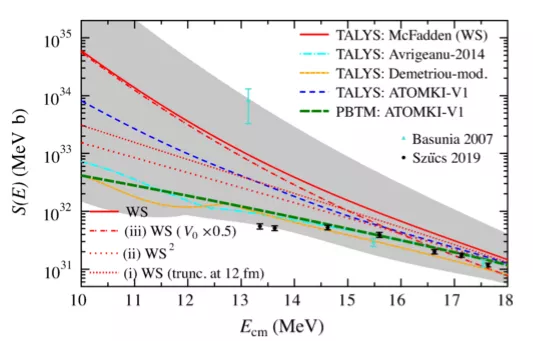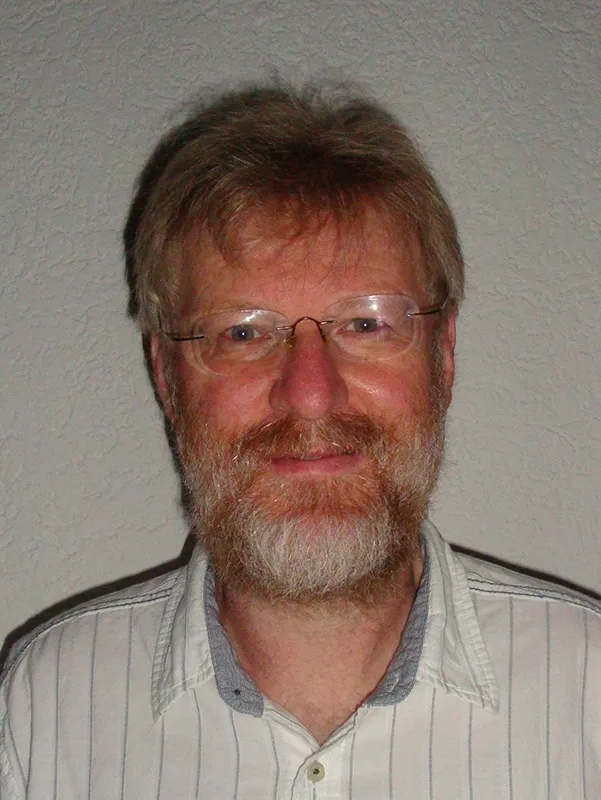Nuclear reactions involving alpha particles play a vital role in the synthesis of heavy chemical elements, especially in the so-called astrophysical p-process. In supernova explosions, the extremely high temperature of several billion degrees of Kelvin causes the heavy isotopes to emit alpha particles in reactions induced by gamma-radiation. The rate of these kinds of reactions strongly influences the amount of heavy elements produced by the supernova. Therefore, the experimental and theoretical investigation of these reactions is necessary for the successful application of astrophysical supernova models.

Despite the high temperature, the interaction energies are very low from the perspective of nuclear physics. At such low energies the calculated reaction rates greatly depend on basic nuclear physics parameters such as the so-called alpha-nucleus optical potential. Variations of orders of magnitude can be found depending on the chosen potential, which introduces high uncertainty in supernova models.
In the present work, an alternative approach has been developed for the description of these astrophysically important low-energy reactions. Instead of the commonly used, yet problematic complex potentials, a simpler potential form is suggested and the reactions are treated in a fusion model. Surprisingly, this simplified model successfully reproduces practically all the available experimental data, even in cases where the more sophisticated models failed. The excellent performance of the method is demonstrated in the publication by a comparison of the calculated reaction rates with the available experimental data. Additionally, as a further example, a new reaction rate is provided for the transmutation from 180Os to 176W; both nuclei are unstable, and thus an experimental determination of this transmutation rate is practically impossible. This rate has been identified as highly important for the astrophysical p-process. Findings show that this rate is significantly lower than previous predictions.


The nuclear astrophysics group of Atomki (Institute for Nuclear Research, Debrecen) launched a comprehensive study of p-process nucleosynthesis using their low-energy particle accelerators.

This study includes the experimental determination of alpha- and proton-induced reactions relevant to the p-process and low-energy alpha elastic scattering experiments. Their study gained considerable interest from the international community, indicated by an ERC starting grant and the fact that Debrecen was the host of one edition of the “Nuclei in the Cosmos” conference series, which is world-leading event in this field.

Peter Mohr is a German nuclear physicist who graduated from Universität Tübingen, Germany, in 1995. During his PhD years, he had connections with Atomki during workshops in Brussels in 1993 and Budapest in 1994 (the latter being organized by Atomki). After his PhD, he joined a group at Vienna, Austria, and the early contacts to Atomki were intensified by his participation in an Austrian-Hungarian exchange program. Later, Peter Mohr received a habilitation degree from Technische Universität Darmstadt in 2003. Since 2003, he works in Medical Physics and is now head of the Medical Physics Group at Diakonie-Klinikum Schwäbisch Hall, Germany. In 2020, Peter Mohr received the honorary award of “Outstanding Referee” from the American Physical Society.
Since 1995, there has been an ongoing collaboration between Peter Mohr and Atomki, starting with the Austrian-Hungarian exchange program. Finally, he is now a joint member of the Atomki Nuclear Astrophysics Team carrying out studies in the field. He has enjoyed the kind hospitality of Debrecen for over 20 years.
Peter Mohr has used various facilities at Atomki for a series of experiments. The results of his first experiment at Atomki were already published back in 1997, and to date approximately 20 common studies have been published in various highly-regarded scientific journals. Results of the successful collaboration were summarized in a review article in 2013, which was awarded the “Highly Cited Research” title in 2016. The present publication combines the idea of using a different model approach with the results from the earlier 2013 review and is thus the result of over 20 years of work. As the new publication opens the door to more reliable predictions of astrophysical transmutation rates, the collaboration is expected to continue to provide interesting results in the future.
Physical Review Letters 124, (2020) 252701, 2020/6.
P. Mohr, Zs. Fülöp, Gy. Gyürky , G.G. Kiss, and T. Szücs
DOI: https://doi.org/10.1103/PhysRevLett.124.252701